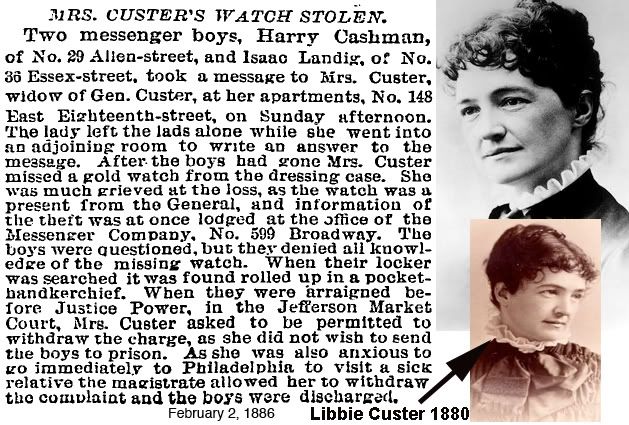
from Civil War Women
...After Custer's death, Libbie moved to New York, where she sought work to supplement her small widow's pension. She wrote three books about their life at frontier posts in order to ensure that Custer's memory would always be honored. In Boots and Saddles: Life in Dakota with General Custer, published in 1885, she describes her life from 1873 to 1876, and compellingly presents the shared anxiety of wives left at Fort Lincoln while their husbands fought and died at Little Big Horn.
In Tenting on the Plains: General Custer in Kansas and Texas (1887), she describes her experiences following General Custer in Kansas and Texas from 1865 to 1867. Insects, illness, and scorpions dominate her recollections of the march to Texas, and her Kansas memories include prairie fire, flood, and cholera.
In 1890, Libbie published her last book, Following the Guidon, in which she picks up the story when her husband returned to duty in Kansas in 1868 to join the campaign culminating in the Battle of Washita. She vividly recalls her fearful visits with captured Native Americans and tribal peace council delegates, while glorifying her husband's honest treatment of those he helped defeat.
Throughout her 57 years of widowhood, Mrs. Custer worked untiringly to defend her husband's reputation and transform him into a hero. She influenced a number of writers, and in all her works, her husband emerged as an exemplary son, brother, husband, and conscientious commanding officer. Since the army and the public saw Libbie as a model wife and a devoted widow, many Custer critics withheld their comments during her lifetime.
Known throughout her life for her undying devotion to her husband, Libbie was the only officer's wife to live in a tent on the edges of a Civil War battlefield, ride in the ranks with the soldiers, and accompany the 7th Cavalry on many of its expeditions. During those adventures, she wore her own uniformed dresses to show her dedication to her husband and the US Army.
Libbie Bacon Custer remained utterly devoted to her husband and never remarried. She died at her home in New York City on April 4, 1933, a few days before her 91st birthday. She was buried at West Point Military Academy next to her husband. They had no children.


























2 comments:
The statement that Custer fathered no children with Libby Custer is correcvt but may not be the whole story. There is now strong evidence that Custer fathered one or more children with Indian women he took as "concubines" during his Western military campaigns with the 7th Cavalry following the Civil War. The most famous of these children is "Yellow Swallow" the fair-skinned son of Monahseetah of the Southern Cheyenne tribe.
That is speculation by a few authors anonymous, and has no fact to back it up. Legitimate writers may mention this rumor that started with Frederick Benteen who is a known Custer hater.However, they will tell you that there is nothing to back this up. Even the Indians who claim that Monahsetah was secretly married to Custer say they never saw a child. They heard stories of a child but had never seen one. Some have the child as a boy, but most have the child as a girl.
There is however some proof that Custer could not father a child. He has a bad case of gonorrhea while at West Point. As bad as this sounds today, in the 1800s and especially at West Point many of the cadets were treated for this. Most took the medicine and were fine. It is documented that Custer however had to go back and get a second dose of medicine for his would not go away. It took him a while to get over this disease. Usually a case such as his will lead to infertility. Which would most likely explain why after 12 years of marriage the Custers never had any children.
Post a Comment